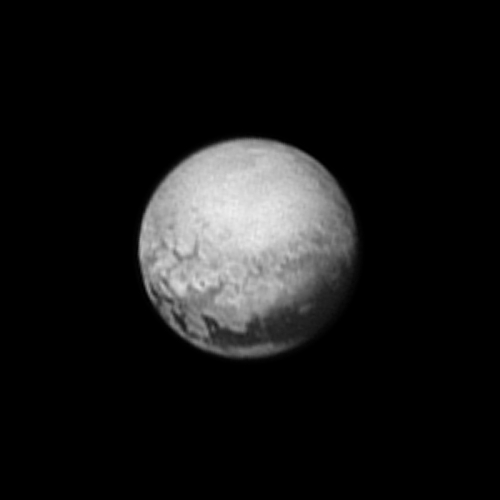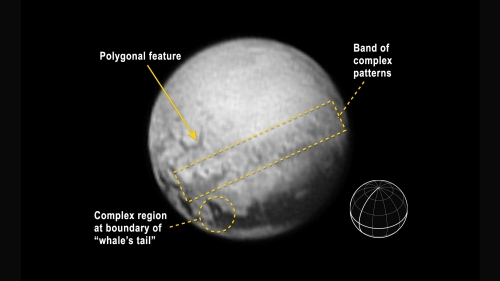Pluto’s surface is beginning to be revealed, with the first signs of geological features, as principal investigator Alan Stern explains:
“Among the structures tentatively identified in this new image are what appear to be polygonal features; a complex band of terrain stretching east-northeast across the planet, approximately 1,000 miles long; and a complex region where bright terrains meet the dark terrains of the whale. After nine and a half years in flight, Pluto is well worth the wait.”

Image: Tantalizing signs of geology on Pluto are revealed in this image from New Horizons taken on July 9, 2015 from 3.3 million miles (5.4 million kilometers) away. At this range, Pluto is beginning to reveal the first signs of discrete geologic features. This image views the side of Pluto that always faces its largest moon, Charon, and includes the so-called “tail” of the dark whale-shaped feature along its equator. (The immense, bright feature shaped like a heart had rotated from view when this image was captured. Among the structures tentatively identified in this new image are what appear to be polygonal features; a complex band of terrain stretching east-northeast across the planet, approximately 1,000 miles long; and a complex region where bright terrains meet the dark terrains of the whale. Credit: NASA/Johns Hopkins University Applied Physics Laboratory/Southwest Research Institute.
The annotated image below includes a reference globe showing Pluto’s orientation, with equator and central meridian in bold.

And the photo below speaks for itself. It’s been nine years. Pluto at last.

Image: Science team members react to the latest New Horizons data from Pluto at the Johns Hopkins University Applied Physics Lab on July 10, 2015. Left to right: Cathy Olkin, Jason Cook, Alan Stern, Will Grundy, Casey Lisse, and Carly Howett. Photo by Michael Soluri.



If I wasn’t a grown up I’d be wetting myself woth excitment over the next week…
Starting to look like Triton now,
http://www.thelivingmoon.com/43ancients/04images/Triton/PIA01536a.jpg
Everyone seems to be saying that Mars is the celestial body that MOST resembles Pluto with respect to color. I intensely dissagree! Mars is RUDDY(a MIX of butterscotch and red, whereas Pluto is CLEARLY Tan and Brown(I can’t see how ANYBODY came up with Orange)! Pluto mostly resembles Titan AT THE SURFACE(go back and review the Huygens pictures JUST PRIOR TO LANDING) My guess is that the “heart” on Pluto is going to STRONGLY resemble the “Xanadu” region of Titan.